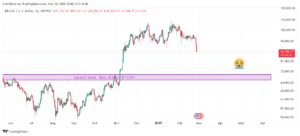Bitcoin’s Price Plunge: A Shocking Market Downturn
Bitcoin, the world’s leading cryptocurrency, has recently experienced a significant downturn, with its price falling below the $90,000 mark for the first time since November 2024. As of February 25, 2025, Bitcoin is trading at approximately $87,959, reflecting a 7.59% decrease from the previous close. This decline has raised concerns among investors and market analysts, prompting an examination of the factors contributing to this downward trend.

Market Overview
The recent slump in Bitcoin’s value is not an isolated event but part of a broader selloff affecting the entire cryptocurrency market. Major altcoins have also suffered substantial losses; for instance, Ethereum has seen its price drop by 9%, trading at $2,402, while XRP has fallen by 7% to $2.21. This widespread decline indicates a shift in investor sentiment and highlights the volatility inherent in the crypto market.
Contributing Factors to Bitcoin’s Decline
Several key factors have been identified as contributors to the recent downturn in Bitcoin’s price:
-
Macroeconomic Pressures: The global economic landscape has been marked by uncertainty, with investors exhibiting aversion to risk assets. This sentiment has been influenced by concerns over potential interest rate hikes by central banks, aiming to combat inflationary pressures. Such monetary policy adjustments can lead to reduced liquidity in financial markets, prompting investors to move away from high-risk assets like cryptocurrencies.
-
Geopolitical Tensions: Recent geopolitical developments, including policy changes and international trade disputes, have added to market volatility. For example, the implementation of new tariffs and changes in immigration policies under the current U.S. administration have created economic uncertainties, impacting investor confidence in various asset classes, including cryptocurrencies.
-
Security Breaches in Crypto Platforms: The security of cryptocurrency exchanges remains a critical concern. A recent high-profile hack involving the Dubai-based platform Bybit resulted in the theft of $1.5 billion worth of assets. Such incidents undermine investor confidence and highlight the vulnerabilities within the crypto ecosystem, leading to selloffs and price declines.
-
Regulatory Concerns: The regulatory environment for cryptocurrencies continues to evolve, with governments worldwide exploring frameworks to oversee digital assets. Uncertainty regarding future regulations can deter institutional investment and contribute to market instability. Recent discussions about stricter regulatory measures have likely influenced the current bearish trend in the crypto market.
Impact on Cryptocurrency-Linked Stocks
The decline in Bitcoin’s price has had a ripple effect on stocks associated with the cryptocurrency industry. Companies such as Robinhood, Coinbase Global, and Marathon Digital Holdings have experienced stock price reductions ranging from 4% to 5%. Similarly, Riot Platforms Inc. and MicroStrategy have seen their shares decrease by approximately 5%. These declines reflect the interconnected nature of the cryptocurrency market and traditional financial markets, where negative trends in digital assets can influence investor sentiment toward related equities.
Historical Context
Bitcoin’s history is marked by periods of rapid appreciation followed by significant corrections. For instance, in 2018, Bitcoin experienced a dramatic crash, with its price falling by about 65% from January to February of that year. Such volatility is characteristic of the cryptocurrency market, influenced by a combination of speculative trading, regulatory news, and macroeconomic factors. Understanding this historical context is essential for investors navigating the current market dynamics.
Analyst Perspectives
Market analysts offer varied perspectives on Bitcoin’s future trajectory:
-
Anthony Scaramucci, head of a leading crypto ETF, maintains an optimistic outlook, predicting that Bitcoin could reach $200,000 in 2025. He attributes this potential growth to increased institutional adoption and the possibility of the U.S. government establishing a strategic Bitcoin reserve. Scaramucci’s firm has seen substantial returns from investments in the digital asset ecosystem, including companies like MicroStrategy and Coinbase.
-
Tony Sycamore of IG and Kyle Rodda of Capital.com express caution, suggesting that Bitcoin’s price could fall further, possibly toward the $70,000 to $80,000 range. They cite ongoing market volatility, geopolitical uncertainties, and recent security breaches as factors that could contribute to additional downward pressure on Bitcoin’s price.
Investor Considerations
For investors, the current downturn presents both challenges and opportunities:
-
Risk Assessment: Given the inherent volatility of the cryptocurrency market, it’s crucial for investors to assess their risk tolerance and ensure that their crypto investments align with their overall financial strategy.
-
Diversification: Diversifying investment portfolios can help mitigate potential losses. Allocating assets across various sectors and asset classes can reduce exposure to the volatility of any single investment.
-
Long-Term Perspective: While short-term fluctuations can be unsettling, some analysts advise maintaining a long-term perspective. The underlying technology and increasing adoption of cryptocurrencies may offer growth potential over an extended horizon.
Conclusion
The recent decline of Bitcoin below the $90,000 threshold underscores the volatile nature of the cryptocurrency market. Factors such as macroeconomic pressures, geopolitical tensions, security concerns, and regulatory uncertainties have all contributed to the current bearish trend. As the market continues to evolve, investors are advised to stay informed, conduct thorough research, and consider their financial goals and risk tolerance when making investment decisions.

